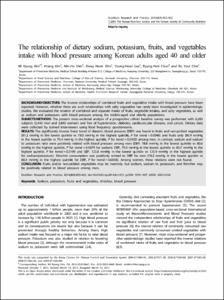KUMEL Repository
1. Journal Papers (연구논문)
1. School of Medicine (의과대학)
Dept. of Preventive Medicine (예방의학)
The relationship of dietary sodium, potassium, fruits, and vegetables intake with blood pressure among Korean adults aged 40 and older
- Keimyung Author(s)
- Shin, Dong Hoon
- Department
- Dept. of Preventive Medicine (예방의학)
- Journal Title
- Asian Nursing Research
- Issued Date
- 2014
- Volume
- 8
- Issue
- 4
- Keyword
- Sodium; potassium; fruits and vegetables; Kimchies; blood pressure
- Abstract
- BACKGROUND/OBJECTIVES: The inverse relationships of combined fruits and vegetables intake with blood pressure have been
reported. However, whether there are such relationships with salty vegetables has rarely been investigated in epidemiologic
studies. We evaluated the relation of combined and separate intake of fruits, vegetable intakes, and salty vegetables, as well
as sodium and potassium, with blood pressure among the middle-aged and elderly populations.
SUBJECTS/METHODS: The present cross-sectional analysis of a prospective cohort baseline survey was performed with 6,283
subjects (2,443 men and 3,840 women) and free of hypertension, diabetes, cardiovascular diseases, and cancer. Dietary data
were collected by trained interviewers using food frequency questionnaire.
RESULTS: The significantly inverse linear trend of diastolic blood pressure (DBP) was found in fruits and non-pickled vegetables
(81.2 mmHg in the lowest quintile vs 79.0 mmHg in the highest quintile, P for trend = 0.0040) and fruits only (80.9 mmHg
in the lowest quintile vs 79.4 mmHg in the highest quintile, P for trend = 0.0430) among men. In contrast, sodium and sodium
to potassium ratio were positively related with blood pressure among men (DBP, 78.8 mmHg in the lowest quintile vs 80.6
mmHg in the highest quintile, P for trend = 0.0079 for sodium; DBP, 79.0 mmHg in the lowest quintile vs 80.7 mmHg in the
highest quintile, P for trend = 0.0199 and SBP, 123.8 mmHg in the lowest quintile vs 125.9 mmHg in the highest quintile
for sodium/potassium). Kimchies consumption was positively related to DBP for men (78.2 mmHg in the lowest quintile vs
80.9 mmHg in the highest quintile for DBP, P for trend = 0.0003). Among women, these relations were not found.
CONCLUSION: Fruits and/or non-pickled vegetables may be inversely, but sodium, sodium to potassium, and Kimchies may
be positively related to blood pressure among men.
Nutrition Research and Practice 2014;8(4):453-462; doi:10.4162/nrp.2014.8.4.453; pISSN 1976-1457 eISSN 2005-6168
Keywords: Sodium, potassium, fruits and vegetables, Kimchies, blood pressure
- Keimyung Author(s)(Kor)
- 신동훈
- Publisher
- School of Medicine
- Citation
- Mi Kyung Kim et al. (2014). The relationship of dietary sodium, potassium, fruits, and vegetables intake with blood pressure among Korean adults aged 40 and older. Asian Nursing Research, 8(4), 453–462. doi: 10.4162/nrp.2014.8.4.453
- Type
- Article
- ISSN
- 1976-1457
- Appears in Collections:
- 1. School of Medicine (의과대학) > Dept. of Preventive Medicine (예방의학)
- 파일 목록
-
-
Download
 oak-aaa-04020.pdf
기타 데이터 / 309.02 kB / Adobe PDF
oak-aaa-04020.pdf
기타 데이터 / 309.02 kB / Adobe PDF
-
Items in Repository are protected by copyright, with all rights reserved, unless otherwise indicated.